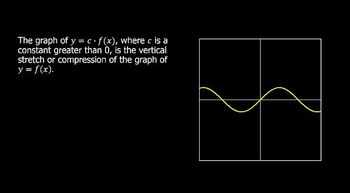Table of contents
- 0. Review of Algebra4h 16m
- 1. Equations & Inequalities3h 18m
- 2. Graphs of Equations43m
- 3. Functions2h 17m
- 4. Polynomial Functions1h 44m
- 5. Rational Functions1h 23m
- 6. Exponential & Logarithmic Functions2h 28m
- 7. Systems of Equations & Matrices4h 6m
- 8. Conic Sections2h 23m
- 9. Sequences, Series, & Induction1h 19m
- 10. Combinatorics & Probability1h 45m
3. Functions
Transformations
Problem 57
Textbook Question
In Exercises 55–59, use the graph of to graph each function g. 
g(x) = -f(2x)
 Verified step by step guidance
Verified step by step guidance1
Identify the original function f(x) from the given graph.
Apply the horizontal compression by a factor of 2 to the function f(x) to get f(2x). This means you will compress the graph horizontally by a factor of 2.
Reflect the graph of f(2x) over the x-axis to get -f(2x). This means you will invert the graph vertically.
Plot the new function g(x) = -f(2x) using the transformations applied in the previous steps.
Verify the transformations by comparing key points from the original graph to the transformed graph.
Recommended similar problem, with video answer:
 Verified Solution
Verified SolutionThis video solution was recommended by our tutors as helpful for the problem above
Video duration:
2mPlay a video:
Was this helpful?
Key Concepts
Here are the essential concepts you must grasp in order to answer the question correctly.
Function Transformation
Function transformation refers to the process of altering the graph of a function through various operations, such as shifting, reflecting, stretching, or compressing. In this case, the function g(x) = -f(2x) involves a reflection across the x-axis and a horizontal compression by a factor of 2. Understanding these transformations is crucial for accurately graphing the new function based on the original function f.
Recommended video:

Domain & Range of Transformed Functions
Reflection Across the X-Axis
Reflecting a function across the x-axis involves changing the sign of the output values. For the function g(x) = -f(2x), this means that for every point (x, f(x)) on the graph of f, the corresponding point on g will be (x, -f(x)). This transformation results in the graph of g being a mirror image of f with respect to the x-axis, which is essential for visualizing the new function.
Recommended video:

Reflections of Functions
Horizontal Compression
Horizontal compression occurs when the input values of a function are scaled by a factor greater than 1, effectively 'squeezing' the graph towards the y-axis. In the function g(x) = -f(2x), the factor of 2 compresses the graph of f horizontally by half. This means that points on the graph of f will be reached more quickly in g, altering the overall shape and behavior of the graph.
Recommended video:

Horizontal Parabolas

 5:25m
5:25mWatch next
Master Intro to Transformations with a bite sized video explanation from Nick Kaneko
Start learningRelated Videos
Related Practice
























